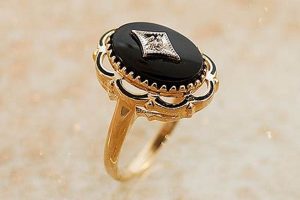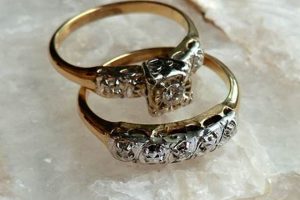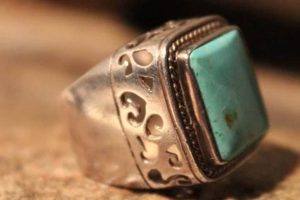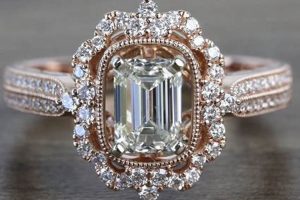These pieces of jewelry are crafted from repurposed antique silverware, typically spoons, transformed into wearable adornments for the fingers. The bowl and handle of a spoon are carefully shaped and bent to form a circular band, often retaining the original decorative patterns and hallmarks of the silverware. Examples include rings crafted from ornate Victorian-era spoons or Art Deco-style flatware.
The appeal lies in their unique character and historical significance. Each ring carries a connection to the past, reflecting the artistry and craftsmanship of a bygone era. Furthermore, creating jewelry from discarded silverware contributes to sustainability by repurposing materials and giving them new life. The resulting jewelry can represent both individuality and environmental consciousness.
The following sections will delve into the history, design variations, collectible value, and maintenance considerations associated with these repurposed items.
Acquiring and Maintaining Silverware Jewelry
The following guidelines offer assistance in selecting and preserving repurposed silverware jewelry.
Tip 1: Identify Hallmarks. Examine the piece for maker’s marks and silver fineness stamps (e.g., “Sterling,” “925”). Hallmarks offer clues about the age, origin, and material composition, which can impact value and desirability.
Tip 2: Assess Design Integrity. Inspect the ring for structural soundness. Look for cracks, weak solder joints, or excessive wear that might compromise its durability. Consider the design’s originality and visual appeal.
Tip 3: Verify Authenticity. Be cautious of reproductions or pieces misrepresented as antique. Research common silverware patterns and manufacturers to differentiate genuine articles from imitations.
Tip 4: Evaluate Silver Condition. Tarnish is normal, but excessive corrosion or pitting can detract from the ring’s beauty and value. Mild tarnish can usually be removed with gentle polishing.
Tip 5: Inquire about Modifications. Understand if and how the silverware was altered to create the ring. Excessive cutting or bending can weaken the metal or distort the original design.
Tip 6: Consider Wearability and Comfort. Ensure the ring’s edges are smooth and do not cause irritation. Check that the size and shape are appropriate for comfortable, everyday wear.
Tip 7: Research Fair Market Value. Before purchasing, compare prices of similar items from reputable sources to ensure you are paying a reasonable amount. Consider the rarity, design, and condition when assessing value.
These tips offer a foundation for informed purchasing and proper care, maximizing the longevity and enjoyment of these unique pieces.
The concluding section will provide a final overview of silverware jewelry, summarizing its place in fashion and history.
1. Silverware Origin
The origin of the silverware used in crafting these rings is intrinsically linked to their value, aesthetic appeal, and historical significance. The manufacturing source, era, and design styles embedded in the original silverware dictate the resulting ring’s character. For example, a piece crafted from a Gorham sterling silver spoon from the late 19th century will possess distinct qualities compared to one made from a mid-century modern design. The manufacturer’s reputation, the silver’s purity, and the rarity of the specific pattern all contribute to the ring’s perceived value and collectibility. The origin directly influences the ring’s market positioning and its appeal to specific collectors or buyers.
Understanding the silverware’s origin allows for a deeper appreciation of the craftsmanship and the historical context of the ring. Hallmarks provide crucial information about the maker, location, and date of production, enabling a detailed tracing of the object’s provenance. Such knowledge is essential for authentication, valuation, and preservation. The designs reflect prevailing artistic trends, so knowing that a spoon came from a specific period allows for better interpretation of its aesthetic and its reflection of culture and society. This insight transforms the ring from a mere piece of jewelry into a tangible artifact that captures a moment in history.
Therefore, the origin of the silverware used in construction is more than a mere detail; it fundamentally shapes the identity, worth, and historical resonance of these rings. Recognizing and understanding these origins enhances the buyer’s appreciation, aids in valuation, and underscores the piece’s unique story. Neglecting the silverware origin is neglecting a core element defining the jewelry, hindering its correct evaluation and long-term preservation.
2. Design variations
The inherent flexibility of silverware, specifically spoons, enables a spectrum of design variations in the creation of rings. These variations stem from the original spoon’s shape, pattern, and size, influencing the final aesthetic of the resulting ring. A spoon with an elongated, ornate handle might be transformed into a ring featuring intricate scrollwork, while a simpler, more utilitarian spoon could yield a minimalist band. The depth and curvature of the spoon’s bowl can be incorporated to create rings with unique textures or focal points. Thus, the initial design of the spoon directly dictates the possibilities and limitations of the jewelry crafted from it.
Furthermore, the adaptation techniques employed during the crafting process introduce additional design variations. The metal can be shaped through bending, hammering, and soldering, each technique influencing the final form. Certain artisans may favor retaining the spoon’s original hallmarks as decorative elements, integrating them into the ring’s design. Others might opt to completely reshape the metal, creating abstract or geometric patterns. The presence or absence of gemstones, enamel work, or other embellishments further contributes to the diversity of design options. Consequently, a wide range of aesthetic expressions are possible, from faithful reproductions of vintage silverware patterns to entirely original artistic interpretations.
The consideration of design variations is paramount for collectors and enthusiasts. The design influences the ring’s value, wearability, and historical significance. Recognizing the subtle nuances in design allows for informed selection and appreciation. A deeper understanding enables accurate assessment of craftsmanship and originality. Ultimately, exploring the design variations helps in classifying rings based on style, era, and the artisans involved, contributing to a richer, more informed experience with these unique pieces.
3. Metal composition
The metal composition of repurposed silverware dictates its durability, aesthetic characteristics, and value. Predominantly, rings are crafted from sterling silver (92.5% silver, alloyed with other metals) or silverplate (a base metal coated with a thin layer of silver). Sterling silver rings exhibit greater longevity and resistance to tarnish, while silverplate rings are more susceptible to wear, exposing the underlying base metal. Nickel silver (also known as German silver), despite its name, contains no silver and should be identified accordingly. Understanding the metal composition is crucial for assessing the piece’s authenticity, determining its potential for restoration, and evaluating its market price. For instance, a sterling silver ring retains a significantly higher value than a silverplate version due to the intrinsic worth of the metal. Hallmark identification is essential for determining accurate metal content.
The crafting process is directly affected by the metal composition. Sterling silver offers malleability suitable for shaping and bending, allowing for intricate designs. Conversely, base metals in silverplate require careful handling to avoid damaging the thin silver layer. Metal allergies are also a consideration. Nickel, often used as a base metal in silverplate, can trigger allergic reactions in some individuals. Therefore, disclosing the metal composition is crucial for ethical sales practices. Polishing methods also vary depending on the metal. Abrasive polishes can quickly wear away silverplate, while gentler methods are required for sterling silver to preserve its patina.
In summary, metal composition plays a pivotal role in defining the characteristics, value, and maintenance requirements. Accurate identification through hallmarks and material testing is vital for both buyers and sellers. The composition affects the ring’s lifespan, wearability, and potential for causing allergic reactions. Considering the metal content promotes informed purchasing decisions, ethical trading, and appropriate care, ultimately contributing to the preservation and appreciation of repurposed silverware jewelry.
4. Crafting Techniques
The techniques employed in repurposing antique silverware into finger adornments are central to their character, durability, and value. These methods encompass metalworking skills passed down through generations, adapted for the unique constraints and opportunities presented by working with existing objects.
- Bending and Shaping
This core technique involves manipulating the spoon’s form to create a circular band suitable for wearing as a ring. Skilled artisans employ specialized tools and leverage to bend the metal without causing cracks or distortions. The method preserves the spoon’s inherent curvature while achieving the desired ring shape. For example, carefully annealing the metal before bending reduces stress and prevents breakage. Improper bending can lead to weakened areas or unsightly kinks, diminishing the ring’s structural integrity and aesthetic appeal.
- Cutting and Filing
Selective removal of material is often necessary to achieve the desired ring profile and eliminate sharp edges. Jewelers’ saws and precision files are used to trim excess metal and refine the ring’s shape. Careful attention is required to avoid damaging the original silverware pattern or removing too much material, which can compromise the ring’s strength. For instance, filing down the edges of a spoon handle to create a smooth, comfortable band requires a delicate balance between material removal and preserving the design. Inadequate filing can result in rough edges that irritate the wearer’s skin.
- Soldering and Joining
In some designs, separate pieces of silverware might be joined to create a more elaborate ring. Soldering, the process of fusing metal pieces together with a filler metal, is used to create secure and aesthetically pleasing connections. The choice of solder, the application of heat, and the skill of the artisan are crucial to ensure a strong and invisible join. For example, soldering a decorative element from another spoon onto the ring band requires precise alignment and a careful application of heat to prevent melting or distorting the surrounding metal. Poor soldering can result in weak joints that break under stress.
- Polishing and Finishing
The final stage involves polishing the ring to remove tarnish, scratches, and imperfections, revealing the metal’s luster. Different polishing compounds and techniques are used depending on the metal’s composition and desired finish. Silver polish is commonly used on sterling silver rings, while more gentle methods are needed for silver-plated pieces to avoid removing the plating. An example would be using a buffing wheel and rouge to achieve a high shine on a completed ring. Overzealous polishing can erode fine details or damage delicate patterns, while inadequate polishing can leave the ring looking dull and unappealing.
These crafting techniques, when skillfully applied, transform discarded silverware into unique pieces of wearable art. The quality of these techniques directly impacts the ring’s durability, appearance, and value. Recognizing and appreciating these skills enhances the appreciation and proper evaluation. Rings created with substandard techniques are prone to damage and reduced appeal.
5. Hallmark identification
Hallmark identification represents a crucial step in authenticating and valuing repurposed silverware jewelry. The marks imprinted on the original silverware provide vital clues about its origin, metal content, and manufacturer. Accurate interpretation of these marks enables the determination of the piece’s historical context and inherent value.
- Manufacturer Attribution
Hallmarks frequently include symbols or initials representing the silversmith or manufacturing company. Identifying the manufacturer establishes the item’s provenance and allows for research into the company’s history, design characteristics, and quality standards. For example, a hallmark featuring the Gorham Manufacturing Company’s mark indicates American origin and potentially a specific design period. This knowledge contributes significantly to assessing the value and collectibility.
- Silver Standard Verification
Hallmarks often denote the silver standard of the metal. Markings such as “Sterling,” “925,” or other numerical indicators confirm the silver’s purity. This verification impacts the valuation, as sterling silver pieces command a higher price than silver-plated items. The absence of such marks raises concerns about the ring’s authenticity and metal composition. An example could be a hallmark indicating “800” silver, signifying a lower silver content than sterling.
- Date and Location Markers
Some hallmarks include date letters or symbols indicative of the year the silverware was produced, as well as marks indicating the location of the assay office or manufacturer. These markers provide valuable insights into the ring’s age and geographical origin. Analyzing these markers allows collectors to trace the ring back to a specific time period and region, enriching its historical narrative. An example includes British hallmarks with date letters corresponding to the year of manufacture.
- Pattern Recognition
Hallmarks, when combined with design elements, facilitate the identification of specific silverware patterns. Pattern identification allows for comparative analysis, assessing rarity, and determining the design’s popularity. Recognizing a known silverware pattern can enhance a ring’s desirability among collectors and increase its market value. An example would be identifying a specific Reed & Barton pattern through a combination of hallmark and design motifs.
The ability to accurately identify hallmarks transforms what might seem like a simple piece of jewelry into a tangible connection to the past, allowing enthusiasts to delve into the historical context and artistic legacy embedded within the silver. Furthermore, identifying hallmarks enables consumers to make informed purchasing decisions, avoiding misrepresentation and ensuring fair market value.
6. Ring sizing
Accurate ring sizing is paramount when dealing with repurposed silverware jewelry, particularly given the unique characteristics of the source material and the potential challenges in alteration.
- Non-Standard Sizes and Shapes
Antique silverware pieces were not originally intended for use as rings, resulting in variations in thickness and curvature. Therefore, standard ring sizing tools may not accurately reflect the interior circumference. Rings crafted from spoons with thicker handles will possess a different feel and fit compared to those from thinner spoons, even if they measure the same size according to a ring mandrel. This necessitates careful consideration of the ring’s internal shape and thickness when determining the appropriate size.
- Limited Adjustability
Silverware is typically more rigid than jewelry-grade metal, limiting the extent to which a completed ring can be resized. Aggressive bending or stretching can damage the piece or compromise its structural integrity. Consequently, selecting a ring that closely matches the intended finger size is crucial. Attempting to force a ring that is too small can lead to discomfort or injury, while a ring that is too large may slip off and be lost. Modifications must be carefully considered to prevent damage to the original design.
- Consideration of Spoon Bowl Inclusion
Certain designs retain a portion of the spoon’s bowl as a decorative element. This can affect the ring’s balance and how it sits on the finger. A ring with a prominent bowl feature may require a slightly larger size to accommodate the additional bulk. Additionally, the wearer’s finger shape should be considered, as individuals with wider knuckles might need to select a larger size to comfortably pass the ring over the knuckle.
- Professional Sizing Recommended
Given the factors discussed above, it is advisable to have one’s finger professionally sized by a jeweler before purchasing repurposed silverware rings. A jeweler can assess the finger’s shape and size and recommend a suitable ring size based on the design and construction of the piece. Furthermore, a jeweler can advise on potential resizing options and assess the feasibility of altering the ring without damaging it.
In summary, accurate ring sizing represents a critical consideration for these pieces due to non-standard shapes and sizes, as well as limited adjustability. Ignoring these factors can lead to dissatisfaction, discomfort, or damage. Consulting with a jeweler familiar with vintage silverware can significantly improve the likelihood of a comfortable and aesthetically pleasing fit.
7. Tarnish management
Effective tarnish management is crucial for preserving the aesthetic appeal and value of these rings. Silver, the primary metal component, is inherently susceptible to tarnishing, a chemical reaction with sulfur compounds in the air that results in a dark, dull surface layer. Neglecting tarnish management leads to diminished beauty, potential damage to intricate designs, and a reduction in the jewelry’s overall value.
- Regular Cleaning Protocols
Routine cleaning is essential to prevent the buildup of tarnish. Gentle polishing with a soft cloth and specialized silver cleaning solutions removes nascent tarnish without causing abrasion or damage. Infrequent cleaning allows tarnish to accumulate, requiring more aggressive methods that pose a risk to delicate features. For instance, wiping a ring with a treated polishing cloth after each wearing can significantly reduce the need for more intensive cleaning. Failure to implement regular cleaning leads to severe tarnish requiring professional intervention.
- Appropriate Storage Methods
Proper storage minimizes exposure to environmental factors that accelerate tarnishing. Storing silverware jewelry in airtight containers or tarnish-resistant pouches limits contact with air and moisture. Placing anti-tarnish strips or cloths within storage containers absorbs sulfur compounds, further inhibiting tarnish formation. An example includes storing each ring individually in a soft, flannel bag within a closed jewelry box. Improper storage, such as leaving rings exposed to open air and humidity, promotes rapid tarnishing.
- Selection of Cleaning Agents
The choice of cleaning agents impacts both the efficacy of tarnish removal and the long-term integrity of the metal. Harsh abrasives and overly aggressive chemical cleaners can scratch the silver surface or damage delicate patterns. Opting for gentle, pH-neutral silver polishes and avoiding prolonged exposure to cleaning solutions minimizes the risk of damage. For example, using a silver polishing paste specifically formulated for antique items, rather than a general-purpose metal cleaner. Inappropriate cleaning agents can lead to permanent damage.
- Professional Restoration Considerations
Severely tarnished or damaged rings might require professional restoration. Skilled jewelers employ specialized techniques and equipment to remove heavy tarnish and repair structural damage without compromising the piece’s historical integrity. Professional restoration often involves ultrasonic cleaning, careful polishing, and the repair of worn or broken components. For instance, entrusting a severely tarnished ring with intricate filigree to a professional restorer ensures that the delicate details are preserved. Attempting advanced restoration without proper training can result in irreparable harm.
In summary, proactive tarnish management is indispensable for safeguarding the longevity and aesthetic value. Implementing regular cleaning protocols, employing appropriate storage methods, selecting gentle cleaning agents, and considering professional restoration options are all integral components of a comprehensive tarnish management strategy. Neglecting these aspects diminishes the visual appeal, increasing the risk of damage, and reducing the financial worth.
Frequently Asked Questions
This section addresses common inquiries regarding the acquisition, care, and historical context of rings made from repurposed silverware, providing informed guidance and dispelling potential misconceptions.
Question 1: Are rings crafted from repurposed silverware considered authentic antiques?
The authenticity of a ring crafted from repurposed silverware depends on the age of the original silverware. The silverware itself may be antique, but the ring, as a newly constructed item, is more accurately described as a repurposed or upcycled piece. The value lies in the age and provenance of the original silverware.
Question 2: What factors contribute to the value of these rings?
Several factors influence the price, including the silver’s purity (sterling silver commanding a higher value), the silverware’s manufacturer and pattern (rarer patterns increasing value), the ring’s design and craftsmanship, and the overall condition of the ring.
Question 3: How can potential buyers verify the authenticity of a ring?
Authentication involves examining the ring for hallmarks that indicate the silver’s purity and manufacturer. Researching the maker’s marks and comparing them to known silverware patterns confirms the origin. Reputable dealers should provide detailed information regarding the origin and silver content.
Question 4: What cleaning methods are recommended for rings made from vintage silverware?
Gentle cleaning with a soft cloth and a specialized silver polish designed for antique items is recommended. Abrasive cleaners can scratch the surface or damage delicate patterns. Regular cleaning prevents the buildup of tarnish and preserves the ring’s luster.
Question 5: Are there any potential health concerns associated with wearing these rings?
Potential health concerns primarily involve nickel allergies. Silver-plated items often contain nickel as a base metal, which can cause allergic reactions in sensitive individuals. Opting for rings made from sterling silver minimizes this risk.
Question 6: How should repurposed silverware rings be stored to prevent tarnishing?
Rings should be stored in airtight containers or tarnish-resistant pouches to minimize exposure to air and moisture, which accelerate tarnishing. Placing anti-tarnish strips or cloths within storage containers further protects the silver.
These answers provide a basic understanding of repurposed silverware rings. It’s essential to consider these factors when acquiring or caring for these unique pieces.
The following section will provide the final overview of this topic.
Conclusion
This exploration has detailed various aspects of “vintage spoon rings,” from their historical origins and design variations to considerations of metal composition, crafting techniques, hallmark identification, ring sizing, and tarnish management. Recognizing the nuances involved in their creation and care ensures informed appreciation.
The continued interest in repurposed silverware jewelry underscores the enduring appeal of combining historical significance with sustainable practices. These pieces stand as a testament to resourcefulness and artistry, inviting individuals to connect with the past while embracing environmentally conscious choices.







